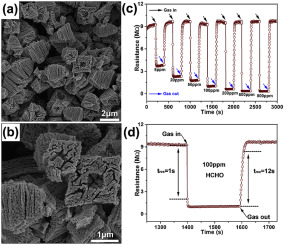当前位置:
X-MOL 学术
›
J. Alloys Compd.
›
论文详情
Our official English website, www.x-mol.net, welcomes your
feedback! (Note: you will need to create a separate account there.)
Constructing chinky zinc oxide hierarchical hexahedrons for highly sensitive formaldehyde gas detection
Journal of Alloys and Compounds ( IF 5.8 ) Pub Date : 2019-02-01 , DOI: 10.1016/j.jallcom.2018.10.122 Shuangming Wang , Jing Cao , Wen Cui , Longlong Fan , Xifei Li , Dejun Li
Journal of Alloys and Compounds ( IF 5.8 ) Pub Date : 2019-02-01 , DOI: 10.1016/j.jallcom.2018.10.122 Shuangming Wang , Jing Cao , Wen Cui , Longlong Fan , Xifei Li , Dejun Li

|
Abstract The gas sensing performances of chemical sensors can be optimized not only by functionalization of sensing materials, but also via artful structural design. Herein, we develop a highly sensitive formaldehyde (HCHO) gas sensor by exploiting chinky zinc oxide (ZnO) hexahedrons, which are successfully synthesized by a facile room-temperature solution strategy combined with a subsequent calcination process. Microstructural characterizations by means of scanning electron microscopy and X-ray diffraction indicate that as-prepared ZnO hexahedrons are assembled by numerous nanoparticles and present porous chinky hexahedron architectures. When applied as a gas sensing material, the resulting ZnO hexahedrons show enhanced response towards formaldehyde gas compared with ZnO nanoparticles. Moreover, rapid response (1 s) and recovery speed (12 s), superior selectivity, and well stability and reproducibility are also observed in ZnO hexahedrons based sensors. Benefiting from synergistic sensitization effect of more surface defects, larger surface area and three dimensional hierarchical assembly pattern, ZnO hierarchical hexahedrons facilitate full exposure of active sites and easy adsorption of oxygen and target gases, producing enhanced formaldehyde gas sensing performances. This work not only highlights the advantage of simultaneous sensitization of different strategies, but also further demonstrates the contribution of the assembly pattern of building blocks in improving gas sensing performances of oxide semiconductor based gas sensors.
中文翻译:

构建用于高灵敏度甲醛气体检测的小氧化锌分级六面体
摘要 化学传感器的气敏性能不仅可以通过传感材料的功能化来优化,还可以通过巧妙的结构设计来优化。在本文中,我们通过利用小氧化锌 (ZnO) 六面体开发了一种高灵敏度的甲醛 (HCHO) 气体传感器,该六面体是通过简便的室温溶液策略结合随后的煅烧过程成功合成的。通过扫描电子显微镜和 X 射线衍射进行的微观结构表征表明,所制备的 ZnO 六面体由众多纳米颗粒组装而成,并呈现多孔的六面体结构。当用作气敏材料时,与 ZnO 纳米颗粒相比,所得的 ZnO 六面体对甲醛气体的响应增强。此外,快速响应(1秒)和恢复速度(12秒),在基于 ZnO 六面体的传感器中也观察到了优异的选择性、良好的稳定性和重现性。受益于更多的表面缺陷、更大的表面积和三维分层组装模式的协同敏化作用,氧化锌分层六面体有利于活性位点的充分暴露以及氧气和目标气体的易吸附,从而增强了甲醛的气敏性能。这项工作不仅突出了不同策略同时敏化的优势,而且进一步证明了构建块的组装模式在提高基于氧化物半导体的气体传感器的气体传感性能方面的贡献。受益于更多的表面缺陷、更大的表面积和三维分层组装模式的协同敏化作用,氧化锌分层六面体有利于活性位点的充分暴露以及氧气和目标气体的易吸附,从而增强了甲醛的气敏性能。这项工作不仅突出了不同策略同时敏化的优势,而且进一步证明了构建块的组装模式在提高基于氧化物半导体的气体传感器的气体传感性能方面的贡献。受益于更多的表面缺陷、更大的表面积和三维分层组装模式的协同敏化作用,氧化锌分层六面体有利于活性位点的充分暴露以及氧气和目标气体的易吸附,从而增强了甲醛的气敏性能。这项工作不仅突出了不同策略同时敏化的优势,而且进一步证明了构建块的组装模式在提高基于氧化物半导体的气体传感器的气体传感性能方面的贡献。产生增强的甲醛气体传感性能。这项工作不仅突出了不同策略同时敏化的优势,而且进一步证明了构建块的组装模式在提高基于氧化物半导体的气体传感器的气体传感性能方面的贡献。产生增强的甲醛气体传感性能。这项工作不仅突出了不同策略同时敏化的优势,而且进一步证明了构建块的组装模式在提高基于氧化物半导体的气体传感器的气体传感性能方面的贡献。
更新日期:2019-02-01
中文翻译:

构建用于高灵敏度甲醛气体检测的小氧化锌分级六面体
摘要 化学传感器的气敏性能不仅可以通过传感材料的功能化来优化,还可以通过巧妙的结构设计来优化。在本文中,我们通过利用小氧化锌 (ZnO) 六面体开发了一种高灵敏度的甲醛 (HCHO) 气体传感器,该六面体是通过简便的室温溶液策略结合随后的煅烧过程成功合成的。通过扫描电子显微镜和 X 射线衍射进行的微观结构表征表明,所制备的 ZnO 六面体由众多纳米颗粒组装而成,并呈现多孔的六面体结构。当用作气敏材料时,与 ZnO 纳米颗粒相比,所得的 ZnO 六面体对甲醛气体的响应增强。此外,快速响应(1秒)和恢复速度(12秒),在基于 ZnO 六面体的传感器中也观察到了优异的选择性、良好的稳定性和重现性。受益于更多的表面缺陷、更大的表面积和三维分层组装模式的协同敏化作用,氧化锌分层六面体有利于活性位点的充分暴露以及氧气和目标气体的易吸附,从而增强了甲醛的气敏性能。这项工作不仅突出了不同策略同时敏化的优势,而且进一步证明了构建块的组装模式在提高基于氧化物半导体的气体传感器的气体传感性能方面的贡献。受益于更多的表面缺陷、更大的表面积和三维分层组装模式的协同敏化作用,氧化锌分层六面体有利于活性位点的充分暴露以及氧气和目标气体的易吸附,从而增强了甲醛的气敏性能。这项工作不仅突出了不同策略同时敏化的优势,而且进一步证明了构建块的组装模式在提高基于氧化物半导体的气体传感器的气体传感性能方面的贡献。受益于更多的表面缺陷、更大的表面积和三维分层组装模式的协同敏化作用,氧化锌分层六面体有利于活性位点的充分暴露以及氧气和目标气体的易吸附,从而增强了甲醛的气敏性能。这项工作不仅突出了不同策略同时敏化的优势,而且进一步证明了构建块的组装模式在提高基于氧化物半导体的气体传感器的气体传感性能方面的贡献。产生增强的甲醛气体传感性能。这项工作不仅突出了不同策略同时敏化的优势,而且进一步证明了构建块的组装模式在提高基于氧化物半导体的气体传感器的气体传感性能方面的贡献。产生增强的甲醛气体传感性能。这项工作不仅突出了不同策略同时敏化的优势,而且进一步证明了构建块的组装模式在提高基于氧化物半导体的气体传感器的气体传感性能方面的贡献。











































 京公网安备 11010802027423号
京公网安备 11010802027423号